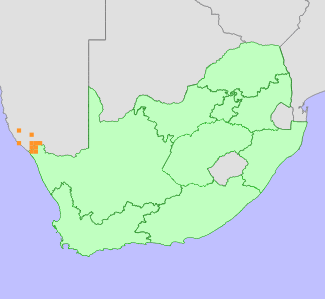|
Scientific Name | Stoeberia gigas (Dinter) Dinter & Schwantes |
Higher Classification | Dicotyledons |
Family | AIZOACEAE |
Synonyms | Mesembryanthemum gigas Dinter, Ruschianthemum gigas (Dinter) Friedrich |
National Status |
Status and Criteria | Critically Endangered A2ace+4ace |
Assessment Date | 2022/08/09 |
Assessor(s) | P.C.V. Van Wyk, N.A. Helme & D. Raimondo |
Justification | A species restricted to the Sperregebiet region of southern Namibia and the Richtersveld region of South Africa. In South Africa it has an extent of occurrence (EOO) of 808 km² and an area of occupancy (AOO) of less than 72 km². More than 80% of the population within South Africa has been lost since 1990 as a result of severe habitat loss due to mining along the Orange River and significant levels of mortality linked to drought over the past 10 years. Loss from mining and drought are predicted to continue over the next 40 years. This long lived succulent shrub that has a minimum generation length of 30 years thus qualifies for listing as Critically Endangered under criterion A. Since the Namibian portion of the population is suspected to also be declining due to mortality from drought, there is no adjustment of its regional status. |
Distribution |
Endemism | Not endemic to South Africa |
Provincial distribution | Northern Cape |
Range | This species occurs is restricted to the Sperrgebiet region in southwestern Namibia and also occurs in the northern Ritchersveld along the Gariep Valley in South Africa. |
Habitat and Ecology |
Major system | Terrestrial |
Major habitats | Desert |
Description | It grows in sandy pockets amongst rocks. |
Threats |
| Its entire range has experienced below average rainfall since 2012. Many former subpopulations, have been lost to drought for example the subpopulation at Brandkaros which has been monitored since 2004 was completely dead by 2021. Predictions of future climate change include further increases in annual average temperature of between 1.4°C and 2.4°C by 2050, which will result in unbearably hot temperatures and ongoing aridification throughout significant portions of the year (Van Wilgen et al. 2017). Within the South African portion of its range it has also lost habitat to mining as most subpopulations are concentrated in the Gariep Valley an area with active and expanding diamond mining. |
Population |
More than 80% of the portion of the population that falls within the South African portion of its range has been lost since 1990 mostly as a result of habitat loss to mining and high levels of mortality caused by the severe drought that has taken place over the past decade. Loss to mining is ongoing and climate models predict ongoing aridification. Thus the population is expected to continue to decline.
|
Population trend | Decreasing |
Assessment History |
Taxon assessed |
Status and Criteria |
Citation/Red List version | | Stoeberia gigas (Dinter) Dinter & Schwantes | Least Concern | Raimondo et al. (2009) | |
Bibliography |
Raimondo, D., von Staden, L., Foden, W., Victor, J.E., Helme, N.A., Turner, R.C., Kamundi, D.A. and Manyama, P.A. 2009. Red List of South African Plants. Strelitzia 25. South African National Biodiversity Institute, Pretoria.
Snijman, D.A. 2013. Plants of the Greater Cape Floristic Region 2: The extra Cape flora. Strelitzia 30. South African National Biodiversity Institute, Pretoria.
|
Citation |
| Van Wyk, P.C.V., Helme, N.A. & Raimondo, D. 2022. Stoeberia gigas (Dinter) Dinter & Schwantes. National Assessment: Red List of South African Plants version 2024.1. Accessed on 2025/12/02 |
 Comment on this assessment
Comment on this assessment


